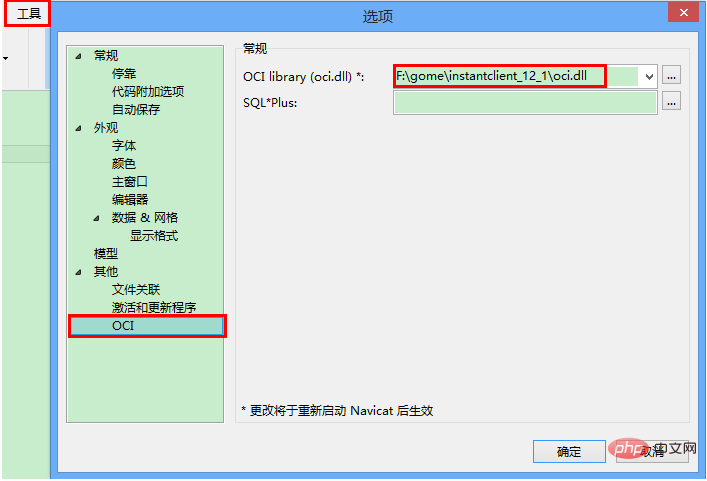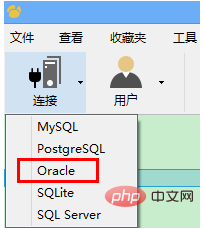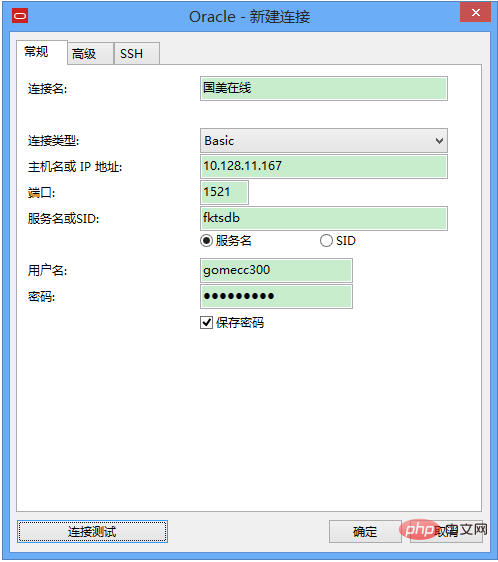Navicat connects to Oracle database (graphic tutorial)
Navicat premium is a database management tool. It is a multi-connection database management tool. It allows you to connect to MySQL, SQLite, Oracle and PostgreSQL databases at the same time with a single program, allowing you to manage different types of databases. The database is more convenient.
1. Software that needs to be prepared
1.Navicat premium 32-bit
Official download address: http://www.navicat.com.cn/products/navicat-premium
2.Instant Client12.1.0.2.0 32-bit
Instant Client is a streamlined version of the client launched by Oracle.
32-bit download address: http://www.oracle.com/technetwork/topics/winsoft-085727.html
Note: Regardless of your Whether Navicat is 32-bit or 64-bit, your Instant Client must download the 32-bit version, because Navicat only supports 32-bit clients.
2. Installation and configuration
1. Unzip Instant Client to
F:\gome\instantclient_12_1
2. Configure Navicat premium’s oci
Navicat Premium comes with default instantclient_10_2, but it is the base lite version (Basic Lite: a streamlined version of Basic, which only has English error messages and Unicode, ASCII and Western European character set support), does not support Chinese character sets, and the server-side oracle in this article It happens to be a Chinese character set, instantclient_10_2 is not suitable, so you need to download the base version.
Set the OCI library in Navicat Premium to F:/gome/instantclient_12_1/oci.dll, and then restart to take effect.

3. Connect to Oracle
1. Open Navicat Premium, click on the connection to select Oracle

##2. Fill in the connection information


3. Problem summary
1. Problem 1: ORA-12737: Instant Client Light: unsupported server character set ZHS16GBK
2. Question 2: only compatible with oci vers and higherion 8.1 and higher
If you are connecting to a remote server, make sure that the local and remote Oracle versions are consistent. If it is 11g, use 11g to prevent problems caused by mismatch between sqlplus and oci. In addition, Navicat seems to only be able to use 32-bit oci. , you can download it from here (http://www.oracle.com/technetwork/topics/winsoft-085727.html.)
3. Question 3: Cannot load OCI DLL,193
This is caused by the inconsistent version of Navicat and Navicat Premium, because Navicat Premium only supports 32-bit Instant Client. Check whether the one you downloaded is a 32-bit Instant Client.
Recommended tutorial: "Oracle Tutorial"
The above is the detailed content of Navicat connects to Oracle database (graphic tutorial). For more information, please follow other related articles on the PHP Chinese website!

Hot AI Tools

Undresser.AI Undress
AI-powered app for creating realistic nude photos

AI Clothes Remover
Online AI tool for removing clothes from photos.

Undress AI Tool
Undress images for free

Clothoff.io
AI clothes remover

Video Face Swap
Swap faces in any video effortlessly with our completely free AI face swap tool!

Hot Article

Hot Tools

Notepad++7.3.1
Easy-to-use and free code editor

SublimeText3 Chinese version
Chinese version, very easy to use

Zend Studio 13.0.1
Powerful PHP integrated development environment

Dreamweaver CS6
Visual web development tools

SublimeText3 Mac version
God-level code editing software (SublimeText3)

Hot Topics
 1386
1386
 52
52
 How to check tablespace size of oracle
Apr 11, 2025 pm 08:15 PM
How to check tablespace size of oracle
Apr 11, 2025 pm 08:15 PM
To query the Oracle tablespace size, follow the following steps: Determine the tablespace name by running the query: SELECT tablespace_name FROM dba_tablespaces; Query the tablespace size by running the query: SELECT sum(bytes) AS total_size, sum(bytes_free) AS available_space, sum(bytes) - sum(bytes_free) AS used_space FROM dba_data_files WHERE tablespace_
 How to view instance name of oracle
Apr 11, 2025 pm 08:18 PM
How to view instance name of oracle
Apr 11, 2025 pm 08:18 PM
There are three ways to view instance names in Oracle: use the "sqlplus" and "select instance_name from v$instance;" commands on the command line. Use the "show instance_name;" command in SQL*Plus. Check environment variables (ORACLE_SID on Linux) through the operating system's Task Manager, Oracle Enterprise Manager, or through the operating system.
 How to encrypt oracle view
Apr 11, 2025 pm 08:30 PM
How to encrypt oracle view
Apr 11, 2025 pm 08:30 PM
Oracle View Encryption allows you to encrypt data in the view, thereby enhancing the security of sensitive information. The steps include: 1) creating the master encryption key (MEk); 2) creating an encrypted view, specifying the view and MEk to be encrypted; 3) authorizing users to access the encrypted view. How encrypted views work: When a user querys for an encrypted view, Oracle uses MEk to decrypt data, ensuring that only authorized users can access readable data.
 How to uninstall Oracle installation failed
Apr 11, 2025 pm 08:24 PM
How to uninstall Oracle installation failed
Apr 11, 2025 pm 08:24 PM
Uninstall method for Oracle installation failure: Close Oracle service, delete Oracle program files and registry keys, uninstall Oracle environment variables, and restart the computer. If the uninstall fails, you can uninstall manually using the Oracle Universal Uninstall Tool.
 How to solve the problem of closing oracle cursor
Apr 11, 2025 pm 10:18 PM
How to solve the problem of closing oracle cursor
Apr 11, 2025 pm 10:18 PM
The method to solve the Oracle cursor closure problem includes: explicitly closing the cursor using the CLOSE statement. Declare the cursor in the FOR UPDATE clause so that it automatically closes after the scope is ended. Declare the cursor in the USING clause so that it automatically closes when the associated PL/SQL variable is closed. Use exception handling to ensure that the cursor is closed in any exception situation. Use the connection pool to automatically close the cursor. Disable automatic submission and delay cursor closing.
 How to check invalid numbers of oracle
Apr 11, 2025 pm 08:27 PM
How to check invalid numbers of oracle
Apr 11, 2025 pm 08:27 PM
Oracle Invalid numeric errors may be caused by data type mismatch, numeric overflow, data conversion errors, or data corruption. Troubleshooting steps include checking data types, detecting digital overflows, checking data conversions, checking data corruption, and exploring other possible solutions such as configuring the NLS_NUMERIC_CHARACTERS parameter and enabling data verification logging.
 How to create cursors in oracle loop
Apr 12, 2025 am 06:18 AM
How to create cursors in oracle loop
Apr 12, 2025 am 06:18 AM
In Oracle, the FOR LOOP loop can create cursors dynamically. The steps are: 1. Define the cursor type; 2. Create the loop; 3. Create the cursor dynamically; 4. Execute the cursor; 5. Close the cursor. Example: A cursor can be created cycle-by-circuit to display the names and salaries of the top 10 employees.
 How to set up users of oracle
Apr 11, 2025 pm 08:21 PM
How to set up users of oracle
Apr 11, 2025 pm 08:21 PM
To create a user in Oracle, follow these steps: Create a new user using the CREATE USER statement. Grant the necessary permissions using the GRANT statement. Optional: Use the RESOURCE statement to set the quota. Configure other options such as default roles and temporary tablespaces.




